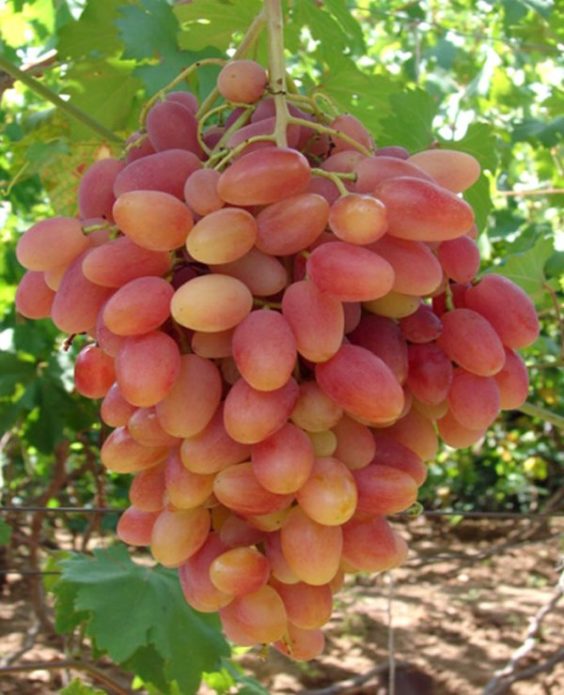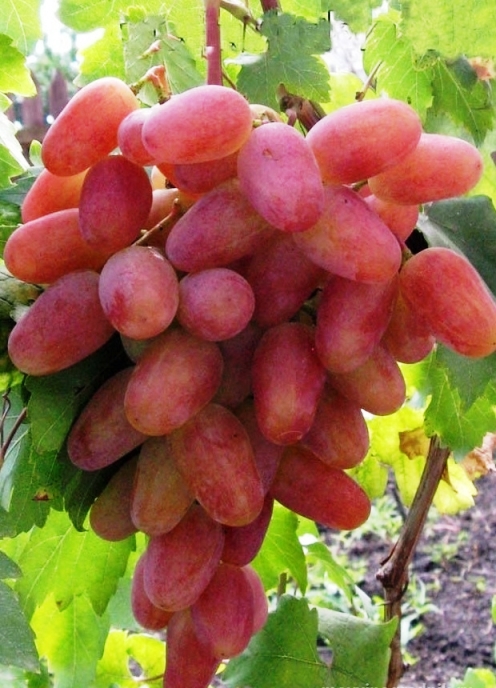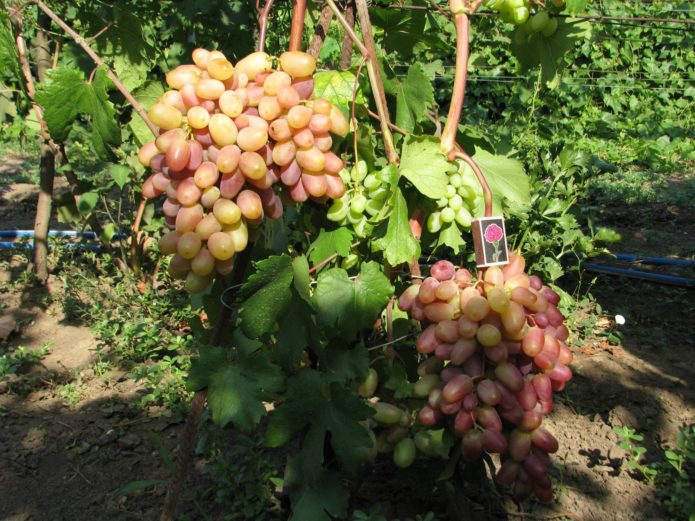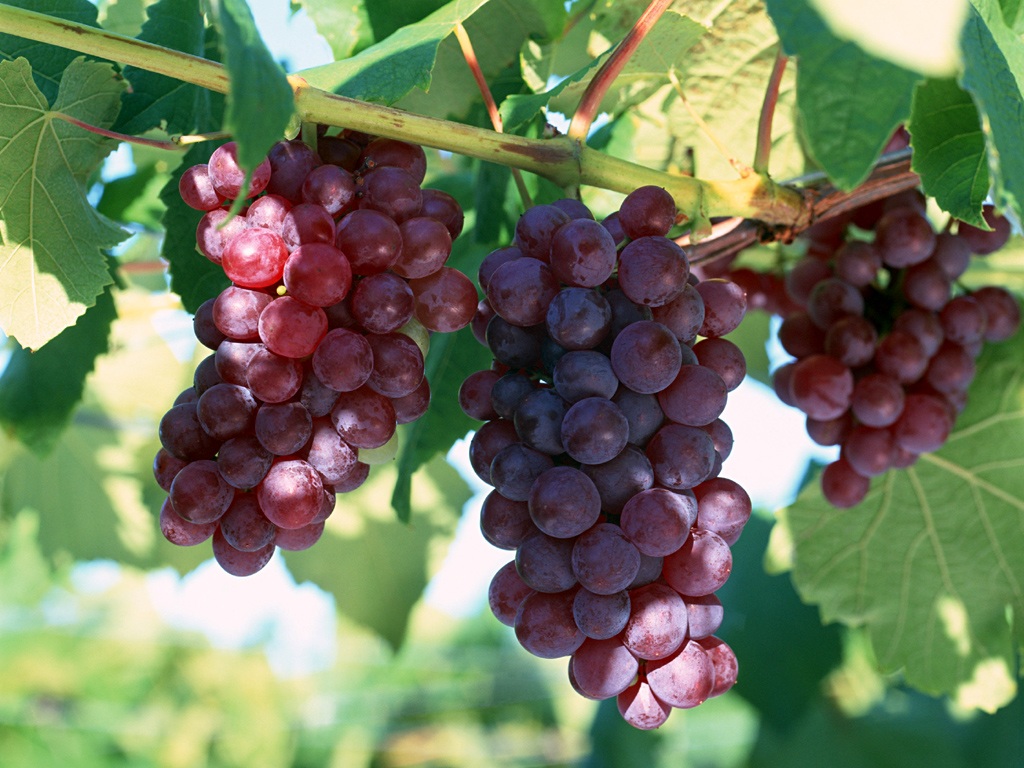Among the currently known grape varieties, Victor is one of the most popular, although the variety is still young. The variety was bred as a result of amateur selection work, but it turned out to be very successful due to the high commercial quality of the berries and the good resistance of the bush to stressful situations. Victor finds application in both farms and amateur farms, since among the varieties of early ripening he is really one of the best.
Content
Breeding history, description and characteristics of the Victor grape variety
Victor grapes is one of the grape varieties bred by the amateur enthusiast V.N.Krainov, who lived in Novocherkassk. Viktor Nikolaevich was called a “private” breeder. Indeed, he did not work in scientific laboratories, but created new grape varieties in his personal garden. As Viktor Nikolayevich himself said, he was engaged in viticulture from the age of 15, from 1953; taught him this by his father, who was also not an agricultural specialist, but a retired military man. Since the summer cottage of V.N.Krainov was located on the banks of the Tuzla River and was distinguished by not very favorable climatic conditions, he tried to create varieties that are resistant to frost, morning dew and fog.
The enthusiast began to develop new varieties only in 1995. In total, a little less than fifty varieties were created by the breeder, and almost all of them are still used today.
The grapes, which give the varieties of the collection of V. N. Krainov, are characterized by the epithets "solid, impressive, giant, gigantic."
The first of them was the NiZina grape, which has already become a legend, and one of the most famous among a wide circle of amateurs is the Transfiguration and the Anniversary of Novocherkassk. The author himself considered the Transfiguration the most successful of his varieties.

According to the creator, the Transfiguration is his best variety in terms of the totality of parameters.
The name of V.N.Krainov is immortalized in the varieties Viktor and Viktor-2 bred by him. The breeder received many of his brainchildren on the basis of various methods of crossing the grape varieties Talisman and Radiant Kishmish; this is how the Victor grape was born, which appeared at the very beginning of our millennium. Victor-2, a raspberry-colored grape very similar to Victor, is often called Sympathy. There is the concept of Krainov's Troika: these are the varieties that best reflect his achievements: Transfiguration, Anniversary of Novocherkassk and Victor.
Victor is a representative of early-ripening grape varieties, it takes a little less than 4 months to fully ripen. It is considered a premium grape: it has an excellent taste and high winter hardiness. Without shelter, the grapes are able to withstand frost around -23 ° C. Since the variety is relatively young, its resistance to diseases and pests has not yet been fully investigated, but at the moment it can be argued that false dew and gray rot are not afraid of it. Victor is little affected by wasps and other representatives of flying insects.
Victor's bushes are vigorous, the shoots grow quickly and ripen well.The variety is early, but many experts attribute it even to the super-early group, since it begins to bloom at the very beginning of summer, the first harvest is ready in early August, and in southern regions sometimes at the end of July. The flowers are bisexual, that is, they do not require replanting on a plot of grapes of another variety for the purpose of pollination.
The yield of the variety is stable, but it cannot be called super-high: it is rarely possible to collect more than 8 kg from a bush. The bunches are usually in the middle between conical and cylindrical, but they are also chaotic; sometimes they reach a mass of 2 kg, but on average are in the range from 600 to 900 g. Packing berries in a cluster of medium density. No peeling is observed. The bunch ripens evenly.
The berries are oval, often with a slightly pointed tip, their size is above average: they reach 15 g in weight, sometimes even more. The color depends on the degree of ripening and the conditions: the berries that are already suitable for consumption may differ slightly from green, be pale pink. But over time, as it matures further, the color turns to burgundy and then to purple. The skin is firm, but edible, does not interfere with consumption. The pulp is tender, tasty, very juicy. Sugar content is slightly higher than average (up to 17%), the total acid content is about 8 g / l.
The purpose of Victor grapes is universal: being an early variety, it is, of course, primarily used fresh, but making juice, compotes from it and processing into raisins is quite possible.
Features of planting and growing grape varieties Victor
From the point of view of planting and cultivation, Victor is an ordinary table grape of an early ripening period, so his agricultural technique does not have any significant features. Victor reproduces well by cuttings, so you can grow his seedling yourself at home. If there is already a frost-resistant young bush of another variety, Victor can be grafted into this bush with a cuttings: the grafting technique is not difficult, but you need to carefully read about the compatibility of varieties, for grapes this is of great importance.
Like all grape varieties, Victor prefers to grow in sunny places, sheltered from the effects of cold winds, and especially drafts. Therefore, when choosing a place for planting, you should choose where there is an obstacle to the north wind: a wall of a house or a fence, although it is not advised to plant it close to fences.
Tall shrubs (jasmine, honeysuckle) also protect well from windmills, but the side facing the southern sun should be open.
Victor loves light soil, grows well on black soil, but tolerates any soil, except for very swampy. It does not require frequent and abundant watering, except for the period of active berry growth. Does not like waterlogging: the groundwater level should be further than 2 m from the soil surface.
The best planting time in most regions is mid-spring. In the south, grapes can be planted in the fall, but young plantings for the winter must be well covered. The planting technique is no different from other varieties, but one should take into account the great strength of growth, so the distance to neighboring bushes or other plantings should be about 3-4 meters.
Since autumn, for spring planting, it is necessary to dig up the entire area around the future bush with fertilizers, filling the soil with nutrients for the next few years. The planting hole for spring planting is also dug in the fall. A pit for Victor grapes is dug at least 80 cm in size in all dimensions. A drainage layer must be placed on the bottom, especially in the case of clay soils: crushed stone, pebbles, broken brick.A layer of soil mixed with fertilizers is poured onto the drainage (several buckets of humus, half a bucket of wood ash, a pound of azofoska), and above it is a layer that will directly contact the young roots: pure fertile soil. The grapes are planted deeply, leaving only 1-2 buds above the ground.
In arid regions, a thick pipe that comes out to the surface should be placed in the planting hole in order to water the grapes directly into the root zone for the first 2-3 years. When planting, the roots should be well spread, covered with soil, tamped and watered well. Mulching the soil around the seedling with a layer of about 3 cm is highly desirable: it prevents the soil from drying out and prevents weeds from growing.
During cultivation, it is necessary to periodically water and feed the grapes. After 2-3 years, in early spring every year, 1-2 buckets of humus should be poured into the grooves dug along the periphery of the bush, and at the beginning of summer a liter can of ash should be poured, slightly embedding it in the soil. Before the beginning of flowering and immediately after its end, foliar dressing with solutions of complex fertilizers is effective. During the growth of berries, top dressing should not contain nitrogen.
Victor wakes up very early in the spring, and if severe frosts are expected, you can delay the swelling of the buds for 1-2 weeks by spraying the grapes with a solution of ferrous sulfate; this measure will also help in the fight against pests and diseases.
Grapes require annual formative pruning: the removal of dried shoots, as well as excess branches thickening the bush. In the spring, since Viktor starts crying early, pruning should be only cosmetic, and most of it should be done before the bushes are sheltered for the winter. In addition, weak, obviously superfluous young shoots should be broken out throughout the growing season. This operation helps to ensure that only the necessary vines remain on the bush by the fall. In total, Victor can leave up to 25-30 shoots. Unfortunately, it is often necessary to cut off the extra clusters, already as they appear. Strong trellis for tying vines are required.
The variety is quite resistant to diseases, but for their prevention, it is advisable to carry out several sprays per season with fungicide solutions. In October - early November, the bushes must be covered for the winter. The variety is frost-resistant, it is not necessary to bury the vines even in the northern regions. It will be enough, having removed the grapes from the trellises, to cover it with spruce branches of coniferous trees.
Video: Victor grape harvest on bushes exposed to spring frosts
Advantages and disadvantages of the variety in comparison with similar
It is difficult to say with which varieties the Victor grapes should be compared. Of course, for any reason, you can find the best and worst varieties, but in the aggregate of characteristics, this is a quite worthy variety. There are varieties of even earlier ripening, varieties with larger berries. There are sweeter berries that keep better. There are varieties that are less susceptible to diseases and more frost-resistant. But there are no varieties ideal in all respects. Victor is one of the most respected grape varieties.
Among its indisputable advantages are:
- rapid growth of shoots and a high percentage of their ripening;
- good rooting of cuttings, allowing trouble-free propagation of grapes;
- the volume of flowers, which does not require the planting of bushes of another variety;
- medium in volume but stable yields;
- lack of "peas" in the bunches;
- early ripeness: the first berries can be tasted at the beginning of August;
- excellent taste of berries and their good appearance;
- universal purpose of berries;
- high frost resistance (guaranteed limit of -23 aboutC is at the level of most modern varieties);
- resistance to a number of diseases.
The most serious disadvantages include:
- very early flowering, requiring special protection measures against possible frost damage to flowers;
- insufficient resistance to wasps: in the event of a mass invasion, it is necessary to put on mesh protection on the clusters;
- resistance not to all diseases: from mildew and oidium it is necessary to carry out preventive spraying.
However, the listed disadvantages are rather arbitrary: with the help of certain measures it is possible to fight them, and the variety has clearly more advantages.
Video: bunches of Victor grapes on the bushes
Reviews
I have two brushes and they are different! The shape of the berries is different. One brush is painted, and the other is the whole! green. I didn't think this was possible. Cool. The one that is colored by pinching. The juice is delicious and the skin is grass. It seems that the household will not let them mature. The grapes, of course, are superb. Surprised many friends and acquaintances. Thanks to Krainov !!!
I want to share my first impressions. I bought Victor a spring vegetative sapling. To date, an increase of 2 vines of a meter by 4 + green cuttings rooting is simply excellent for rooting, my first experience. Disease resistance is better than Arcadia's (planted side by side) with the same care.
This season became a discovery for me and a bomb on my site of the Viktor GF! The bunches and berries are large, I have never had such large grapes. For today, sweet, tasty, the word harmonious taste just fits. For me, that's it! The color is not yet gaining, pale pink. I loaded something two-year-old bushes, I did not expect such large bunches from him. In general, the bushes are vigorous, now the growth of shoots, stepchildren has noticeably stopped, but this is now the case with all varieties. Friends today tried and persuaded to cut a couple of bunches. They said what to expect, already delicious!
The Victor grape is one of the very early ripening varieties, which gained its popularity soon after its appearance in domestic vineyards. Possessing a lot of advantages, both in terms of the quality of the crop and the resistance of the bushes to various unfavorable conditions, the Victor variety is among the best among Russian early table varieties.





